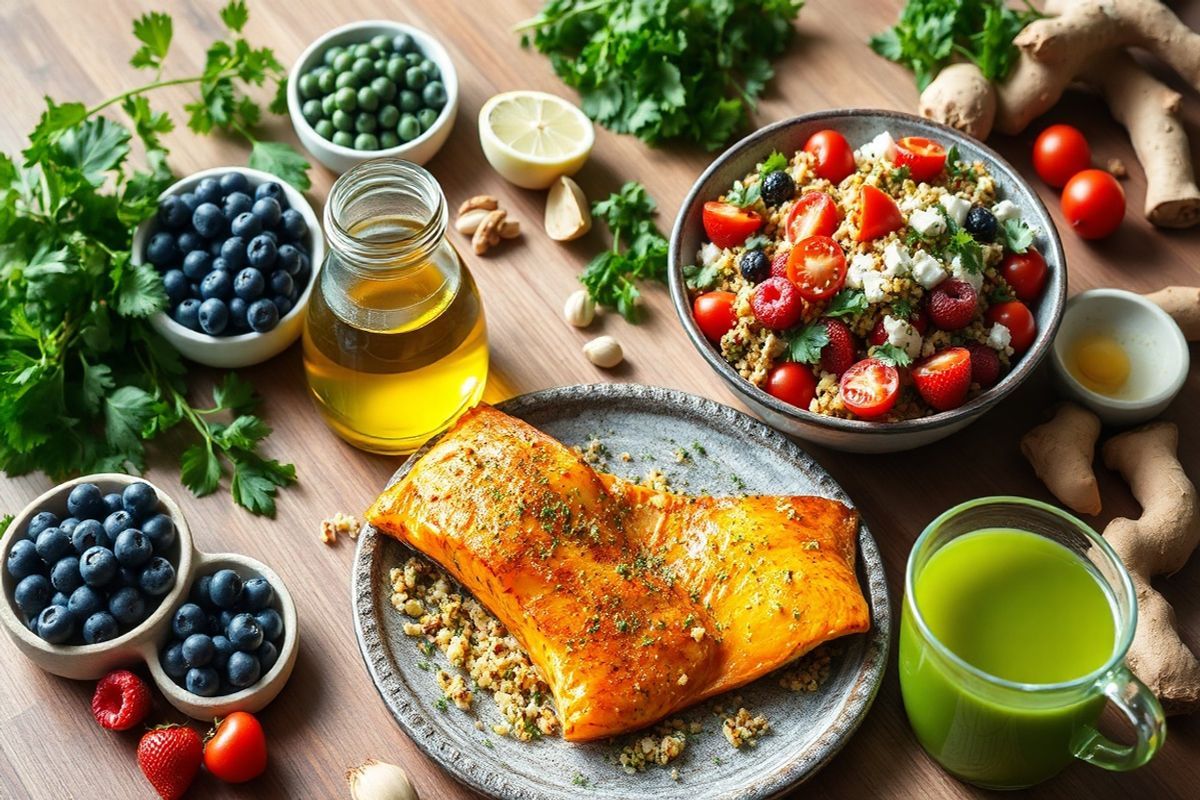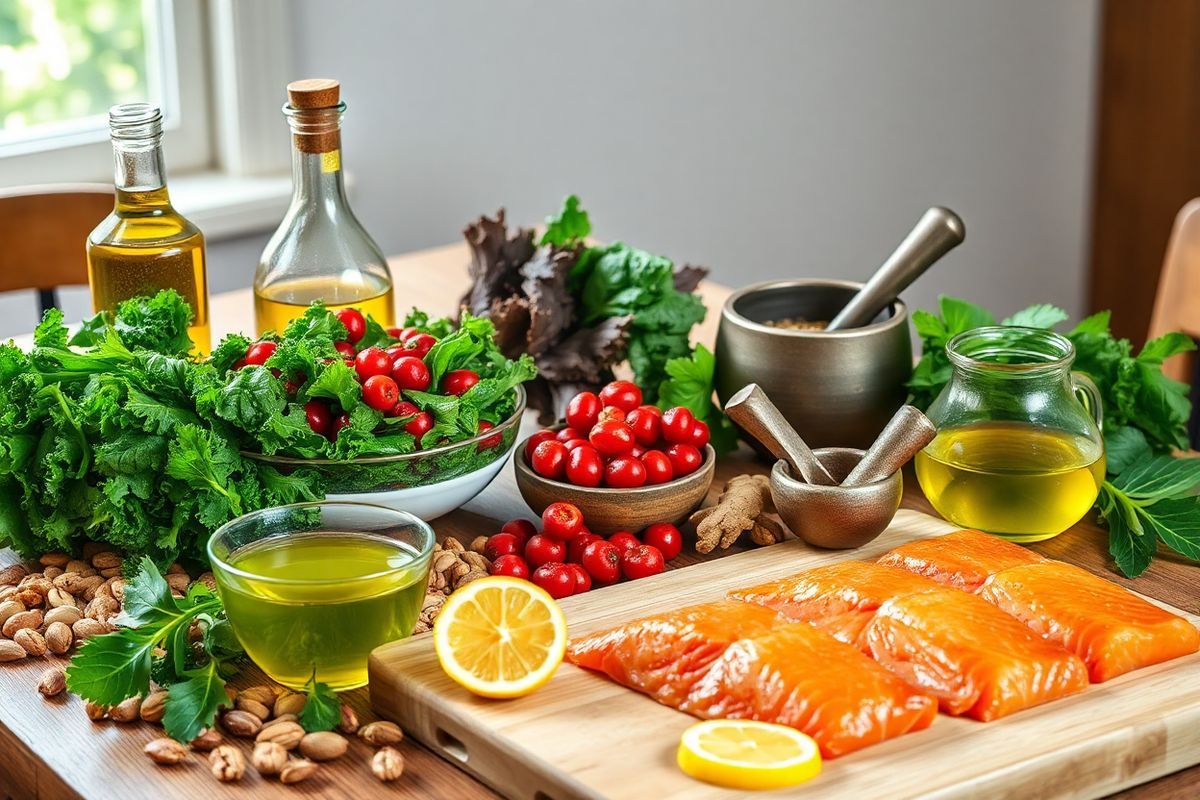Table of Contents
Understanding the Anti-Inflammatory diet: A Path to Wellness

The anti-inflammatory (AI) diet emphasizes the consumption of whole, unprocessed foods while minimizing those that trigger inflammation. This dietary approach is rooted in the Mediterranean and Asian eating patterns, promoting fresh fruits, vegetables, whole grains, healthy fats, and lean proteins. Research indicates that a diet low in processed foods and rich in antioxidants can help mitigate chronic inflammation, which is particularly relevant for those with autoimmune conditions like psoriasis (Meeker, 2022).
Key Principles of the Anti-Inflammatory Diet
-
Lower Sugar Intake: Reducing sugar consumption is vital, as high sugar levels can exacerbate inflammation. The AI diet typically limits sugar intake to between zero and 14 grams per day (Meeker, 2022).
-
Increase Omega-3 Fatty Acids: Foods high in omega-3s, such as fatty fish (salmon, sardines), flaxseeds, and walnuts, should be included. These fats are known for their anti-inflammatory properties (Meeker, 2022).
-
Consume Whole Grains and Vegetables: Whole grains and a variety of vegetables are essential due to their high fiber content, which can help regulate inflammation levels (Meeker, 2022).
-
Limit Dairy and Processed Foods: While fermented dairy can be beneficial, high-fat dairy products and processed foods should be minimized, as they can trigger inflammatory responses (Meeker, 2022).
-
Hydration and Lifestyle Choices: Adequate hydration and healthy lifestyle choices such as regular exercise and stress management are also key components of reducing inflammation (Wesdock, 2022).
Nourishing Ingredients: Key Components for Psoriasis-Friendly Recipes

When crafting anti-inflammatory recipes, consider incorporating the following ingredients known for their healing properties:
| Ingredient | Benefits |
|---|---|
| Fatty Fish | High in omega-3 fatty acids, reduces inflammation. |
| Leafy Greens | Packed with antioxidants and vitamins. |
| Berries | Rich in vitamins and antioxidants, combat oxidative stress. |
| Nuts and Seeds | Source of healthy fats and magnesium. |
| Turmeric | Contains curcumin, which has strong anti-inflammatory effects. |
| Ginger | Known for its anti-inflammatory properties. |
| Olive Oil | Healthy fat that can reduce inflammation when used in moderation. |
| Garlic | Contains compounds that may reduce inflammation. |
| Green Tea | Rich in antioxidants known to combat inflammation. |
These ingredients can serve as the foundation for delicious meals that not only satisfy hunger but also contribute to overall wellness.
Delicious Anti-Inflammatory Recipes to Soothe Psoriasis Symptoms
Here are a few anti-inflammatory recipes that can help alleviate psoriasis symptoms:
1. Mediterranean Quinoa Salad
Ingredients:
- 1 cup quinoa
- 2 cups water
- 1 cup cherry tomatoes, halved
- 1 cucumber, diced
- 1/2 red onion, finely chopped
- 1 cup chickpeas, cooked
- 1/4 cup parsley, chopped
- 1/4 cup feta cheese (optional)
- 1/4 cup olive oil
- Juice of 1 lemon
- Salt and pepper to taste
Instructions:
- Rinse quinoa under cold water. In a saucepan, combine quinoa and water, bring to a boil, then reduce heat and simmer for 15 minutes or until water is absorbed.
- In a large bowl, combine the cooked quinoa, cherry tomatoes, cucumber, red onion, chickpeas, parsley, and feta.
- In a small bowl, whisk together olive oil, lemon juice, salt, and pepper. Pour over salad and toss to coat.
- Serve chilled.
2. Salmon with Turmeric and Ginger
Ingredients:
- 2 salmon fillets
- 1 tablespoon olive oil
- 1 teaspoon turmeric
- 1 teaspoon ginger, grated
- Salt and pepper to taste
- Lemon wedges for serving
Instructions:
- Preheat oven to 400°F (200°C).
- In a small bowl, mix olive oil, turmeric, ginger, salt, and pepper.
- Place salmon on a baking sheet and brush the turmeric mixture over each fillet.
- Bake for 12-15 minutes, or until salmon is cooked through.
- Serve with lemon wedges.
3. Berry Smoothie Bowl
Ingredients:
- 1 cup mixed berries (blueberries, strawberries, raspberries)
- 1 banana
- 1/2 cup almond milk (or other plant-based milk)
- 1 tablespoon chia seeds
- Toppings: sliced fruit, nuts, seeds, granola
Instructions:
- In a blender, combine berries, banana, almond milk, and chia seeds. Blend until smooth.
- Pour into a bowl and top with additional sliced fruit, nuts, seeds, and granola.
- Enjoy as a refreshing breakfast or snack.
These recipes are designed to be easy to prepare while providing nourishment that can help reduce inflammation and support overall health.
Meal Prep Ideas: Easy Ways to Incorporate Anti-Inflammatory Foods
Meal prepping can streamline the process of maintaining an anti-inflammatory diet. Here are some ideas:
- Prepare Grains in Bulk: Cook large batches of quinoa, brown rice, or farro at the beginning of the week. Store in the fridge to use in salads, bowls, or as sides.
- Chop Vegetables Ahead: Spend some time chopping your favorite vegetables and storing them in the fridge for quick access during the week.
- Make Dressing in Advance: Whip up a batch of homemade dressings with olive oil, vinegar, and herbs to dress salads and veggies throughout the week.
- Portion Snacks: Divide nuts, seeds, and cut-up fruits into small containers for easy snacking.
- Batch Cook Soups or Stews: Make a large pot of vegetable soup or a bean chili, portion it out, and freeze for quick meals.
Tips for Success: Making the Anti-Inflammatory Diet Work for You
- Start Slowly: Transition into your anti-inflammatory diet gradually. Begin by replacing one or two meals a week with anti-inflammatory options.
- Listen to Your Body: Pay attention to how different foods affect your psoriasis and overall health. Keep a food diary to track your meals and symptoms.
- Stay Educated: Keep learning about which foods help alleviate inflammation and which trigger it. Knowledge is key to making informed choices.
- Seek Support: Consider working with a registered dietitian or nutritionist who specializes in inflammatory conditions to create a personalized meal plan.
- Be Patient: Dietary changes can take time to show results. Stay committed and give your body the time it needs to adjust.
FAQ
Can an anti-inflammatory diet cure psoriasis?
A: While an anti-inflammatory diet cannot cure psoriasis, it can help manage symptoms and reduce flare-ups by decreasing inflammation in the body.
What foods should I avoid to reduce psoriasis symptoms?
A: It’s best to avoid processed foods, refined carbohydrates, sugary snacks, fried foods, and high-fat dairy products, as these can exacerbate inflammation.
How long does it take to see results from an anti-inflammatory diet?
A: Results can vary, but many individuals may notice improvements in their psoriasis symptoms within a few weeks to a few months of consistent dietary changes.
Is it necessary to eliminate all dairy from my diet?
A: Not necessarily. Some people may tolerate fermented dairy products like yogurt, while others may benefit from reducing or eliminating all forms of dairy. It’s essential to listen to your body.
Can supplements help with psoriasis?
A: While some supplements may support overall health, it’s best to obtain nutrients from whole foods. Always consult with a healthcare provider before starting any new supplements.
References
- Meeker, P. (2022). Five Principles For An Anti-inflammatory diet. Retrieved from https://www.piedmont.org/living-real-change/the-anti-inflammatory-diet
- Wesdock, M. (2022). Psoriasis Diet: Foods to Eat and Avoid If You Have Psoriasis. Retrieved from https://www.hopkinsmedicine.org/health/conditions-and-diseases/psoriasis-diet-foods-to-eat-and-avoid-if-you-have-psoriasis
- El-Saadony, M. T., Fang, G., Yan, S., Alkafaas, S. S., El Nasharty, M. A., Khedr, S. A., … & El-Tarabily, K. A. (2024). Green Synthesis of Zinc Oxide Nanoparticles: Preparation, Characterization, and Biomedical Applications - A Review. International Journal of Nanomedicine. Retrieved from https://doi.org/10.2147/IJN.S487188
- Intharuksa, A., Kuljarusnont, S., Sasaki, Y., Tungmunnithum, D., & Zarrelli, A. (2024). Flavonoids and Other Polyphenols: Bioactive Molecules from Traditional Medicine Recipes/Medicinal Plants and Their Potential for Phytopharmaceutical and Medical Application. Molecules. Retrieved from https://doi.org/10.3390/molecules29235760











